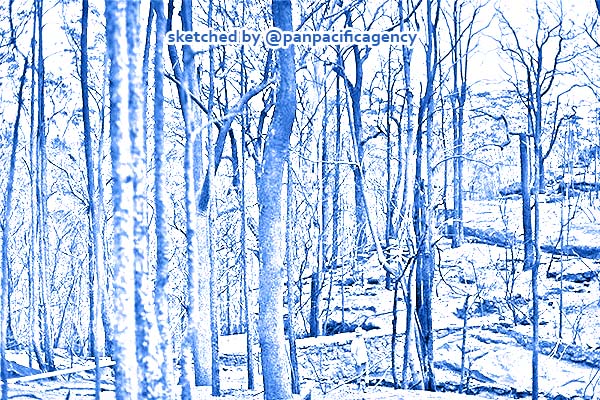[Analytics] Counting the cost of Australia’s raging inferno

This photo taken on January 15, 2020 shows a resident looking at the burnt trees following a bushfire in Budgong area of New South Wales. The confirmed death toll rose to 28 on January 15, as the fires have already destroyed more than 2,000 homes and burnt 10 million hectares (100,000 square kilometres) of land -- an area larger than South Korea or Portugal. AFP/Saeed Khan. Sketched by the Pan Pacific Agency.
Australia’s economy will take years to recover from the bushfires that have devastated four states since September, with the damage bill already estimated at A$5 billion (US$3.4 billion) and the worst of the blazes still to come. Alan Boyd specially for the Asia Times.
There could also be a significant political cost, as Prime Minister Scott Morrison’s indecisive response and adamant refusal to acknowledge a climate change link to the fires have seen his popularity and support nosedive.
Twenty-eight people have been killed and at least 2,300 homes destroyed as the fires burned through 8.4 billion hectares (50,000 square kilometers) of mostly rural land in New South Wales (NSW), Victoria, South Australia and Queensland — a geographical area bigger than the entire territory of Denmark.
Losses will continue to rise, as the peak period of bushfire activity does not start until February, the hottest month in southeastern Australia. It is expected to drag on well into March unless there is rainfall; some areas have had heavy falls in recent days, but not enough to end the fiery crisis.
With insurance claims of A$1 billion ($690 million) already submitted for damage to private property, Westpac bank’s economics unit has calculated that the fires will trim between 0.2-0.5% off growth in 2020 alone.
“That would put the cost in terms of insured and uninsured losses at around $5 billion,” the bank said in a report, noting that the total bill from disasters is generally about double the losses from insured claims.
AMP Capital earlier forecast economic losses amounting to 0.25-1% of gross domestic product (GDP), or a range of A$3-13 billion ($2-9 billion), which could give Australia zero or even negative growth this quarter.
To date the most damaging bushfires were a 2009 inferno that ripped through southeastern Victoria, costing the state A$4.4 billion ($3 billion).
Westpac noted that affected areas this time, mostly on the south coast of NSW and the same region of Victoria burned out a decade ago, account for only 1% of the economy. However, they are major producers of fruit and vegetables, beef, seafood, timber and wine. They are also big tourism areas.
The tourist industry lost at least A$1 billion ($675 million) during the crucial Christmas holiday period due to cancellations— 100% in many destinations — and there is no doubt more to come.
About 60% of bookings in areas unaffected by the bushfires were also scrapped due to adverse media coverage worldwide.
“People have basically stopped travel,” Simon Westaway, executive director of the Australian Tourism Industry Council, told Reuters news agency. “And that’s absolutely understandable: human nature kicks in.”
Damage to telecommunications, power supplies, roads, bridges and other infrastructure is still being evaluated but will also account for millions of dollars, as will the loss of inventories and profits for thousands of small businesses.
Moody’s Analytics economist Katrina Ell said air pollution, which has affected 30% of the population, would result in reduced worker productivity, increased health spending, and lower crop yields. Moody’s, a ratings agency, has said the fires have been more destructive than the 2009 blazes.
Morrison’s conservative government, which staunchly backs fossil fuel use for power generation and rejects claims that climate change has aggravated the fires, was slow initially to respond to the disaster, though it has now offered more than A$2 billion ($1.3 billion) in emergency and reconstruction aid.
The prime minister left for a holiday to Hawaii as NSW was burning, returning only after a media outcry. He was then heckled by victims of the fires on the NSW south coast and criticized by state legislators in his own party.
A Newspoll survey, the first conducted since the worst fires began, found that 59% of respondents were dissatisfied with Morrison’s performance and only 37% satisfied. He now trails Labor’s Anthony Albanese by four percentage points, the survey showed.
Labor, the main opposition party, leads the governing coalition 51% to 49% in two-party preferred terms two years out from the next election. That spread could widen depending on Morrison’s perceived performance in handling the fires’ aftermath.
Morrison contends that it is not his government’s job to fight fires, but conceded that he “could have handled on the ground much better.” Now he has agreed to call a royal commission — the highest level of official inquiry — into the government’s response, providing more fuel to his critics.
Even as the summer fires are quenched, Morrison will continue to feel the political heat. Indeed, there are already rumblings that he may face a leadership challenge among his own ranks in the months ahead.